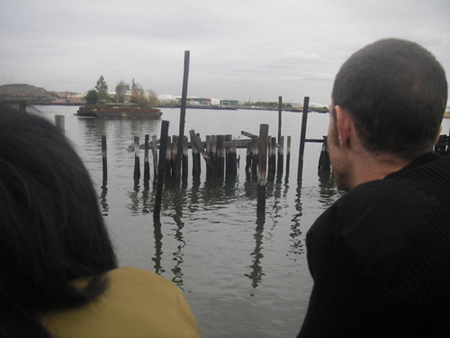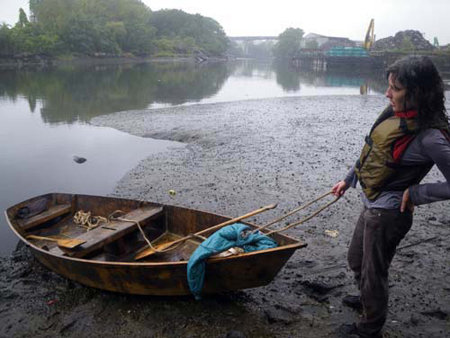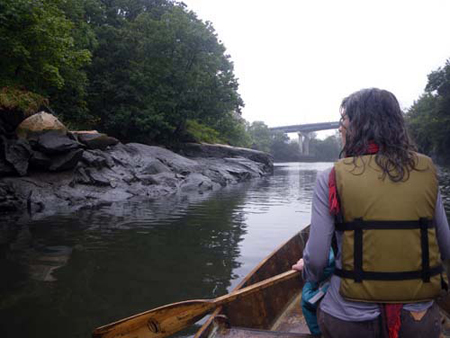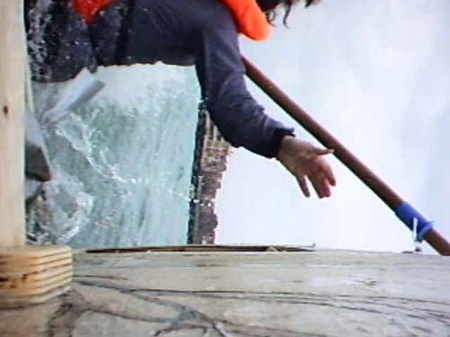Art & Boats is my ongoing series of interviews and stories about artists who build boats, sail, explore and challenge themselves on the water. For background on Art & Boats, read the first entry.
It’s hard to believe that just 100 years ago there were still world maps with areas marked “unexplored.” I recently read that the only uncharted places left on earth were the ocean floors. With the exception of those places under water or ice, every corner of the planet can be observed via Global Positioning Systems. Sophisticated vehicles and satellite devices make adventures, like those of legendary Amazon explorer Percy Fawcett, a romantic notion of the past. Even Fawcett’s mythical lost city of “El Dorado” now shows up on Google Earth.
Artist Marie Lorenz is a modern day explorer, though the territories she traverses are not uncharted, just neglected. Lorenz accesses commercial or disused waterways around New York City in her own custom-made small wooden boats. She visits the canals, rivers and uninhabited islands that form the invisible, industrial and archeological backside of the city. Traveling with one other passenger, Lorenz encounters more freighters and barges than fellow leisure craft. Her journeys have taken her along the Harlem River, Bronx River, Gowanus Canal, Coney Island Creek, and to abandoned islands like North Brother, where the infamous Typhoid Mary was quarantined in the early 1900s. This interview took place by email, the week of March 21, 2010.
Andrea Grover: Your Tide and Current Taxi series involves taking another passenger on a tide and current-driven, boat trip through the industrial watershed and backwaters of New York City, and documenting the shared experience (in photographs and text). Tell me some of your most unusual encounters.
Marie Lorenz: I am always in awe of how the city changes when you drop down below street level into the water. We can be at a busy intersection with cars honking and a few minutes later be drifting along in total silence. So that is always unusual in terms of normal city life. But the thing that jumped to mind to tell you when I read that question, was the unusual amount of naked people I see down by the water when I am out in my boat. I guess because we are floating along, people don’t see us coming or never notice us at all. But I am telling you now, there are large numbers of nude sunbathers all around Manhattan. They climb down to spots along the water, invisible from the street. I try not to take pictures of them, because I want to observe the privacy that they have managed to wrest out of their busy city lives. It is always great to see them. You would never expect it.
AG: The impulse to explore comes through strongly in your work. Are you fond of tales of exploration by sea or any authors in particular?
ML: I love Conrad and Melville. Most of my art projects will kind of startwith literature. and then sometimes other kinds of writing. I did a project at Artpace in San Antonio that was all based on the journals of explorers like Robert Juet, and Meriwether Lewis. But my favorite book of all time, that I think really sort of sums up the pathos ofbeing an artist and how it relates to navigation is “The Strange Last Voyage of Donald Crowhurst”.
AG: The areas you explore are not uncharted, but show little signs of humanity. Do you envision these waterways when they were more integrated into daily life, or is their present day entropy what attracts you?
ML: Both things interest me. I also think that the waterfront is the way that the rest of the world will look in the future. Water dismantles things so quickly, and everything on the water seems to be half falling apart. Then if you think that the ocean levels are rising, and more of the world will be water; new waterfronts created -I think that the view of the city from the water is like a window into the future.
AG: What’s the historical significance to the style of boats you build for these journeys?
ML: I used to make boats that made me think of Egyptian or Phoenician boats. But when I started using fiber glass I was really just going for the easiest things to make with the least amount of material (it has to be light enough for me to carry). I studied boat building in Sausalito, California, but the things I learned there, though they really are a wonderful art form, are too heavy and complicated for me to make in my improvised studios (sometimes a backyard). Everything I make can be made from a local hardware store or even sometimes with scraps. I suppose it has a historic component in relation to exploration; making do with what you have.
AG: Your sailboat capsized at Lido di Ostia, Rome, nearly drowning you and destroying the boat, but you managed to document the entire experience. What possessed you to keep taping?
ML: I actually wasn’t really sure if the camera was taping. I thought it might be, and it was my fathers camera so I was rescuing it from the wreck. I had tried and tried to right the boat before eventually swimming away and I was very upset about losing it. I had spent months making it and the boat felt like my whole reason for being in Rome. I suppose that at some point I must have thought, ok – I lost the boat, this video had better be good. (I ended up finding the boat, buried in the sand about a mile from where it capsized)

Smithson Intervention, invasion of Robert Smithson¹s posthumous public art project, the Floating Island
AG: In your Robert Smithson Intervention, you and your accomplices attempted to board the Floating Island that was circling Manhattan, but the Coast Guard intervened on your intervention. I imagine this isn’t the first time that you’ve been questioned about your actions on the water?
ML: I have been stopped by the Coast Guard, the Police, the Fire Department and I have even been driven home once in a Hazardous Material Safety Administration truck. Everyone I met out there has been great. They tend to understand the nature of the project – people out enjoying the water- after all, they chose to be out there themselves. Every time I am out in the boat in the New York Harbor, you can bet that someone has their eye on me. Other than that Smithson thing, most of the water taxi trips are completely legal. I think that is an important part of the project; that we are doing something that is available to everyone. That said, I am usually trespassing getting to and from the water.
AG: Any news of future trips you’d like to share?
ML: Yes! On April 2nd – 5th I am going to go up the Hudson from Tivoli to Troy, and hopefully stream the trip live. It will be a new kind of story telling for me – the post will be up immediately when I take the picture.
Follow Marie Lorenz’s Tivoli to Troy voyage on her website.







